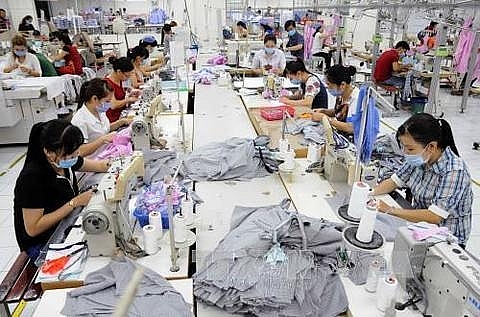Garment firms should meet workers’ needs
 |
| Garment and textile firms should understand the needs of their workers and invest in enhancing human resource management to sustain a productive and quality workforce, a seminar heard in HCM City last Saturday. - VNA/VNS Photo An Hieu |
Pham Xuan Hong, chairman of the HCM City Association of Garment, Textile, Embroidery and Knitting, told the “Develop high quality garment and textile workforce in the context of international business integration” seminar that building a skilled and “high-quality” workforce has always been a major focus for the garment and textile industry.
It is becoming an increasingly important factor since Viet Nam is acceding to many international trade agreements and has to compete with other countries.
According to the 2017 Better Work report published by the International Labour Office and International Finance Corporation, Viet Nam is the fifth largest garment and textile supplier in the world and second largest to the US.
Last year its exports were worth US$34 billion and they are expected to reach $35 billion this year.
According to Dr Pham Xuan Thu, who has done a lot of research on the industry, though the exports are huge the value addition is growing at a very slow pace.
To bolster competition and add more value to Vietnamese garment and textile products, the industry should improve the quality of its workforce, he said.
Also according to the report, the garment sector is the largest formal employer in the country, providing jobs to more than 2.5 million people.
Thu said most garment and textile workers are young, with about 80 per cent of them being under 30, physically fit for the job and very hard-working.
Besides, the rate of workers with technical skills in the industry is 21.1 per cent, which is higher than the average rate of other manufacturing and processing industries, he said. But the industry also faces some challenges such as its productivity, which is lower than the average rate for the country’s industrial sector. With the two of them being VND56 million ($2,460) and VND104.3 million ($4,590) per person per year.
“Though the productivity of major garment firms is much higher than the average rate, Viet Nam has a huge number of small and household garment and textile businesses.”
Another challenge is the high employee turnover rate, he said.
At major garment and textile companies like Nha Be, Viet Tien, and Phong Phu, it is 15-20 per cent.
The number is much higher at small and FDI firms: 20-30 per cent and 30-40 per cent respectively.
Thu said one of the reasons for this is that companies fail to meet the needs of their workers. The monthly salary of a garment worker is around VND4.3 million, which is just enough to cover 75-80 per cent of their basic needs.
“Though the salary has been raised over time there are still companies which fail to pay workers on time, leading to strikes and employees quitting.”
Another reason is that employees tend to switch to other companies to look for better opportunities after getting training and experience, he said. Besides, with the main workforce in the industry being young women emigrant workers, they are highly likely to quit their jobs to marry and return to their hometown after a period of time, he explained.
What the stars mean:
★ Poor ★ ★ Promising ★★★ Good ★★★★ Very good ★★★★★ Exceptional
 Tag:
Tag:
Related Contents
Latest News
More News
- Main drivers for Vietnam’s digital economy future (December 03, 2025 | 11:35)
- Pivotal stage of growth paves way for rise in M&As (December 03, 2025 | 10:00)
- Positive projections for M&A interest from Thailand (December 03, 2025 | 09:40)
- Manifesting the first line of defence in cybersecurity (December 03, 2025 | 09:00)
- The transformational role AI can play in accounting arena (December 03, 2025 | 08:00)
- Unlocking 5G-AI potential in Singapore (December 03, 2025 | 08:00)
- Data-driven strategies vital for a fast-evolving nation (December 02, 2025 | 09:41)
- Policy to practice: how Vietnam can lead the region (November 26, 2025 | 16:03)
- Mobilising private capital at scale vital for climate battle (November 26, 2025 | 15:36)
- VILAF and Yoon & Yang launch Vietnam - Korea Practice Unit (November 26, 2025 | 15:16)























 Mobile Version
Mobile Version